
CBSE Class 12 Maths Notes Chapter 7: CBSE Class 12 Maths Notes Chapter 7 focuses on Integrals , a key concept in calculus. It explores the antiderivatives and indefinite integrals, along with integration as the reverse differentiation process. The chapter introduces various integration techniques, including integration by substitution, parts, and partial fractions.
It also covers the concept of definite integrals, properties of definite integrals, and the application of integrals in finding the area under curves. This chapter builds a strong foundation for solving real-world problems involving rates of change and accumulation, essential for higher studies in mathematics.CBSE Class 12 Maths Notes Chapter 7 Integrals Overview
CBSE Class 12 Maths Notes Chapter 7 PDF
This chapter lays a strong foundation for understanding advanced topics in calculus and is crucial for students pursuing fields like engineering, physics, and economics. Hence, here we have provided CBSE Class 12 Maths Notes Chapter 7 Integrals pdf -CBSE Class 12 Maths Notes Chapter 7 PDF
CBSE Class 12 Maths Notes Chapter 7 Integrals
Here we have provided CBSE Class 12 Maths Notes Chapter 7 -
We already know that the derivative of a function f(x) exists at every point on an interval I if the function is differentiable on that interval. The challenge now becomes: can we obtain the function given the derivative of the function? Yes, is the response to this query. The original function can be obtained through integration, often known as the antiderivative of a function. Integration as an Inverse Process of Differentiation The term "inverse process of differentiation" refers to integration. We are asked to discover a function's primitive, or the original function, given its derivative rather than differentiating it. This kind of procedure is known as anti-differentiation or integration.Antiderivative Functions
Let us have a look at various antiderivative of functions.
Integral Types
The integral calculus is of the two forms, namely(i) Indefinite Integral
(ii) Definite Integral
A constant number "c" follows the value of the function obtained in an indefinite integral because the function's range is not defined. In contrast, a definite integral provides a well-defined function because the function's range is well-defined. The integration's symbol is
Indefinite Integrals
Some of the important concepts of indefinite integrals are as follows: Finding a function's antiderivatives is the process of integration in calculus. Put differently, integration might be thought of as the opposite of differentiation. We will obtain the arbitrary constant C through the process of function integration. The integrals we obtain will vary depending on the value of C. However, geometrically, those integrals are comparable. Here, we'll go into further detail and provide an example on the geometric interpretation of the indefinite integral.Geometrical Interpretation of Indefinite Integral Example
 Where C is called the arbitrary function, which represents the family of integrals.
We are aware that the integral values we obtain vary depending on the value of C. However, their integral values are comparable geometrically. This indicates that we can obtain the many family members that make up the indefinite integral by giving the arbitrary constant different values. As a result, the parabola with its axis along the y-axis is represented by each integral.
Where C is called the arbitrary function, which represents the family of integrals.
We are aware that the integral values we obtain vary depending on the value of C. However, their integral values are comparable geometrically. This indicates that we can obtain the many family members that make up the indefinite integral by giving the arbitrary constant different values. As a result, the parabola with its axis along the y-axis is represented by each integral.
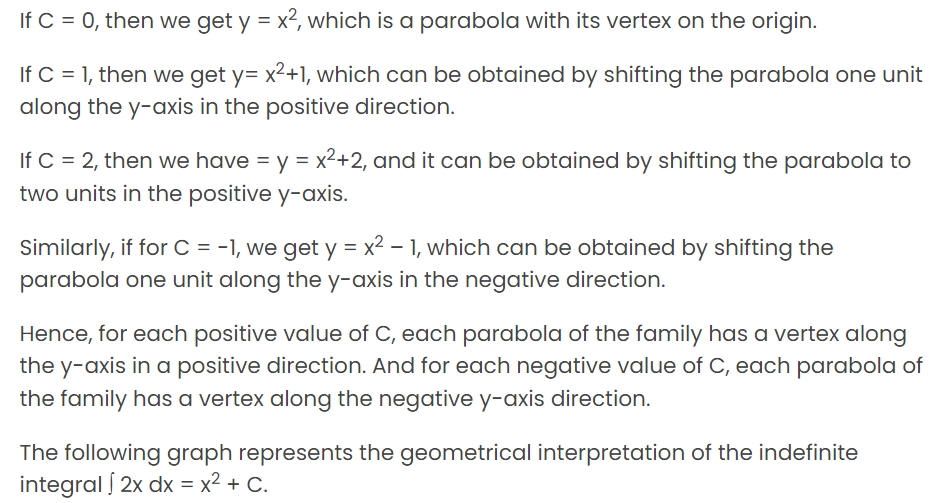
Methods of Integration
There are several ways to find the integral of a function in calculus, or to do integration. These techniques are applied to complicated function antiderivatives. They are as follows: Aside from differentiation, integration is a procedure covered in calculus that allows us to find the integrals of functions. One way to solve integrals is by integration by substitution. Another name for this technique is u-substitution. Here you can also discover integrals of certain functions.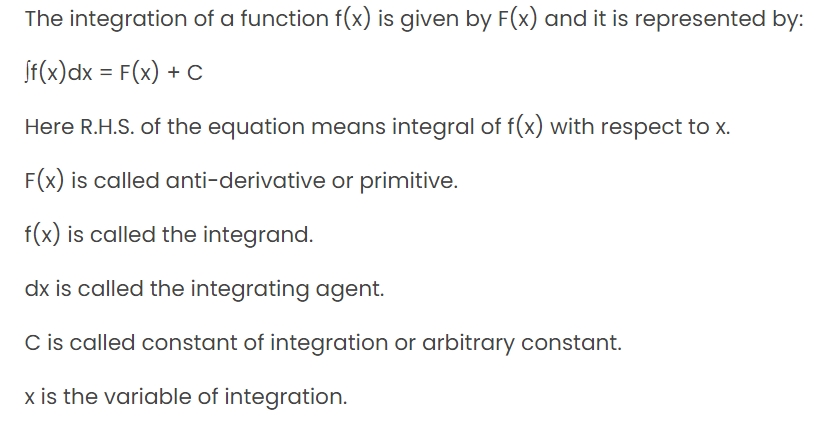 We know the anti-derivatives of fundamental functions. These functions' integrals are easily obtained. However, this integration method is only applicable to fundamental functions; other integration techniques are needed to find the integrals of other functions. Let's talk about integration by substitution among various integration techniques.
We know the anti-derivatives of fundamental functions. These functions' integrals are easily obtained. However, this integration method is only applicable to fundamental functions; other integration techniques are needed to find the integrals of other functions. Let's talk about integration by substitution among various integration techniques.
Integration By Substitution Method
By replacing the independent variable with another, every given integral can be simplified using this integration procedure.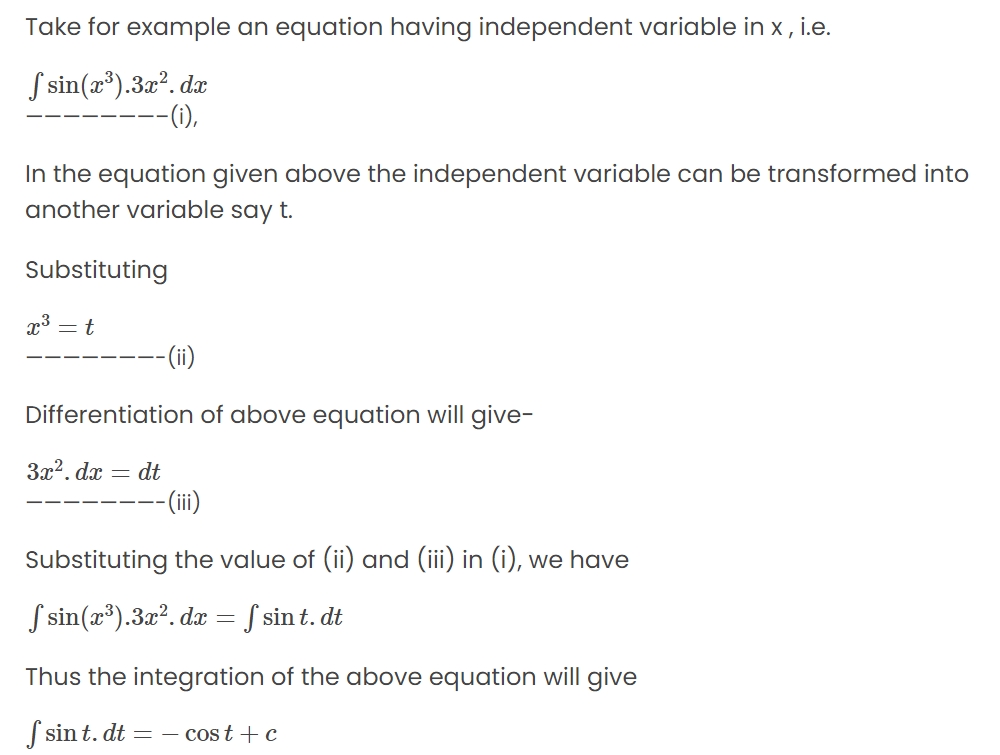
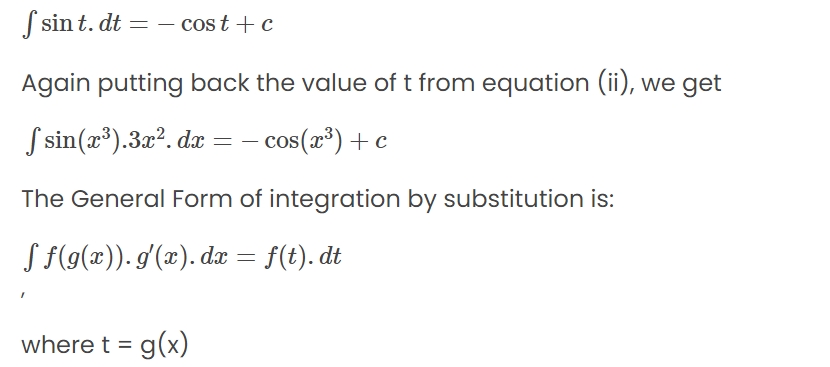
What is a Partial Fraction?
"Partial fractions" are the smaller units from which an algebraic fraction can be decomposed. Take the fraction (3x+5)/(2x2-5x-3) as an example in algebra. One can simplify this statement by splitting it into the form [2/(x – 3)] [1/(2x + 1)]. Partial fractions are the simpler components [1/(2x + 1)] and [2/(x – 3)]. As a result, the algebraic statement can be expressed in the format shown in the figure:Integration By Parts Formula
A unique method of integrating two functions after they are multiplied is called integration by parts. Partial integration is another name for this technique. The integration by replacement approach is an additional way to integrate a given function. Complicated integrations are made simple with the help of these techniques. Integrating a product of two functions by parts can be expressed mathematically as follows:∫f(x).g(x)dx=f(x)∫g(x)dx−∫f′(x).(∫g(x)dx)dx
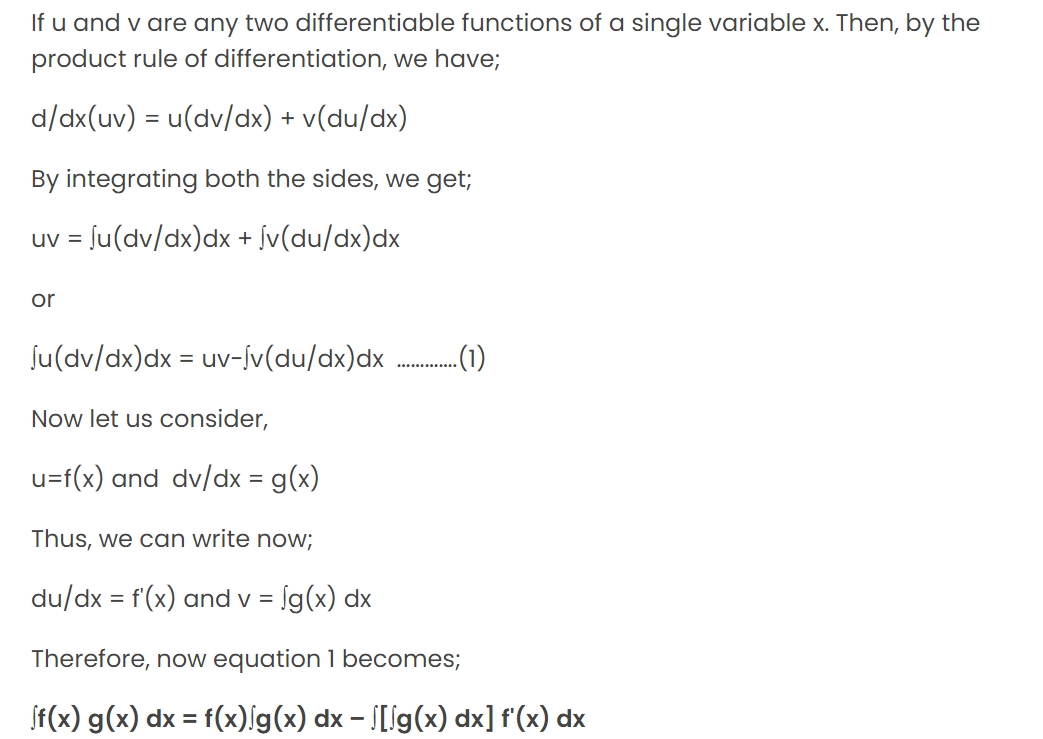
Integration using Trigonometric Identities
The study of differentiation, which includes determining a function's derivative, is the focus of differential calculus. On the other hand, integral calculus is concerned with determining the integral values, which entails determining the function's antiderivative. To put it another way, differentiation is the process that integration is the opposite of.Integrals of Particular Function
The large-scale function summation technique is called an integral. Therefore, the integrals of a few specific functions that are frequently employed in calculations have been covered here. Numerous real-world uses of these integrals include determining the area between curves, volume, average function value, kinetic energy, centre of mass, work-done, and so forth.
Definite Integral
 Here,
∫ = Integration symbol
a = Lower limit
b = Upper limit
f(x) = Integrand
dx = Integrating agent
Thus, ∫
a
b
f(x) dx is read as the definite integral of f(x) with respect to dx from a to b.
Here,
∫ = Integration symbol
a = Lower limit
b = Upper limit
f(x) = Integrand
dx = Integrating agent
Thus, ∫
a
b
f(x) dx is read as the definite integral of f(x) with respect to dx from a to b.
Fundamental Theorem of Calculus
A theorem that connects the ideas of differentiating and integrating functions is known as the fundamental theorem of calculus. By calculating the difference between the antiderivative at the higher and lower bounds of the integration process, the calculus fundamental theorem validates the process. Let's go over the first and second fundamental theorems of calculus, along with how to use them to evaluate the definite integral.First Fundamental Theorem of Integral Calculus (Part 1)
The initial component of the calculus theorem is occasionally referred to as the calculus first fundamental theorem. It states that one of a function f's antiderivatives, or what is also referred to as an indefinite integral, let's say F, can be found as the integral of f with a variable integration bound. This indicates that a continuous function may have antiderivatives. Statement: Let f be a continuous function on the closed interval [a, b] and let A(x) be the area function. Then A′(x) = f(x), for all x ∈ [a, b]. Or Let f be a continuous real-valued function defined on a closed interval [a, b]. Let F be the function defined, for all x in [a, b], by:Second Fundamental Theorem of Integral Calculus (Part 2)
According to the second fundamental theorem of calculus, the following holds true if the function "f" is continuous on the closed interval [a, b] and F is an indefinite integral of a function "f" on [a, b]:F(b)- F(a) = a ∫ b f(x) dx
Here R.H.S. of the equation indicates the integral of f(x) with respect to x. f(x) is the integrand. dx is the integrating agent. ‘a’ indicates the upper limit of the integral and ‘b’ indicates a lower limit of the integral. A definite integral's function has a distinct value. One way to think about a function's definite integral is as a sum's limit. The difference between the values of F, or F(b) – F(a), is the definite integral of the function if there is an antiderivative F of the function in the interval [a, b].Remarks on the Second Fundamental Theorem of Calculus
- The equation ∑ab f(x) dx = (value of the antiderivative F of “f” at the upper limit b) - (the same antiderivative value at the lower limit a) is the second half of the calculus fundamental theorem.
- This theorem is particularly helpful since it gives us a way to estimate the definite integral faster without having to figure out the limit of the sum.
- The fundamental step in estimating a definite integral is determining a function whose derivative equals the integrand. On the other hand, this procedure will strengthen the connection between integration and differentiation.
- The function f(x), or simply "f," in the expression ∫ab f(x) dx, needs to be well-defined and continuous in the interval [a, b].
Benefits of CBSE Class 12 Maths Notes Chapter 7
The benefits of studying Chapter 7 Integrals from CBSE Class 12 Maths are vast, particularly for students looking to strengthen their calculus foundation. Some of the key advantages include:Foundation for Advanced Calculus : Understanding integrals is essential for higher-level calculus topics, such as differential equations and multivariable calculus.
Problem-Solving Skills : The techniques of integration, including substitution, by parts, and partial fractions, enhance a student's ability to solve complex mathematical problems.
Real-Life Applications : Integrals are used in various real-life scenarios, such as calculating areas under curves, solving physics problems related to motion and energy, and determining volumes of solids.
Understanding Definite Integrals : Mastering definite integrals helps students calculate precise areas and values, which are widely applied in economics, engineering, and sciences.
Preparation for Competitive Exams : A strong grasp of integrals is essential for success in competitive exams like JEE, NEET, and other entrance exams that involve mathematics.
Development of Analytical Thinking : Studying integrals nurtures logical and analytical thinking, as students learn to approach problems methodically.
CBSE Class 12 Maths Notes Chapter 7 FAQs
Is integral class 12 hard?
What is the easiest method of integration?
What is the main rule of integration?
Can you integrate multiple times?










